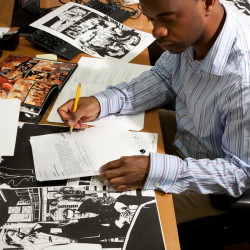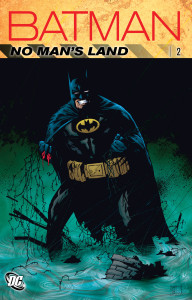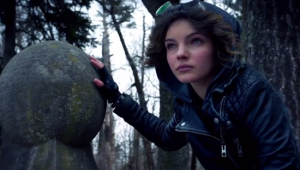Blood, Bone, and Mortar: humanity in the streets of Gotham with Joseph Illidge

Most would argue that every good hero is defined by his rouges gallery; but some would posit that it is the supporting cast…the everyman who populates the world that our myths inhabit that truly defines the heights to which our imagination will soar. After all, these figures are the ones that allow us an access point into the worlds of the incredible that the imagination often craft. With FOX‘s debut of the television series GOTHAM, viewers will be given a ground level view of the places and faces that make DC Comics’ Batman one of the most relate-able heroes in the industry today. Achieving such a distinction is no easy feat; it is something that is arrived at through the efforts of some of the comics industry’s most creative and innovative thinkers as they build worlds that are both fantastic and real at the same time. One such individual, Joseph Illidge (former DC Comics editor with the Batman group), joins CCN to talk about the importance of the city, the people behind the cowl of the Dark Knight and anticipating the upcoming series. Sit back, relax and come away as Mr. Illidge serves as your guide to the blood, bone and mortar of the streets of GOTHAM.
Mark Turner: Having been involved with one of the seminal runs on Detective Comics, you’ve contributed to the development of some of the strongest supporting characters for the Dark Knight’s mythology. With the debut of the new television series, one of those characters, Crispus Allen will be appearing. Can you tell us a bit about how this character was developed? What informed this character’s personality and look? Who is responsible for creating him? Why did editorial feel there was a need for him to have a presence in Gotham City?
Jospeh Illidge: The era of BATMAN: DETECTIVE COMICS that introduced Detective Crispus Allen to the world of Gotham City was developed to really make the book a detective series, about crimes being solved by the experts in that field, and their conflicts with the supervillains of Batman’s rogues’ gallery.
Novelist Greg Rucka took advantage of the new era of Batman to really expand on the lineup of the Gotham City Police Department, and make it a more consistently diverse group of individuals. I always thought Greg purposely named Crispus Allen as a slick reference to Crispus Attucks, the slave who escaped to become a free man and died in The Boston Massacre. Illustrator Shawn Martinbrough realized the look of Crispus. From what I remember, he nailed it right out the gate with his designs. Greg and Shawn succeeded in creating a character with an incorruptible soul and morally adamant resolve, which is different from the Harvey Bullock character from the Batman comics. Crispus was the man you’d want at your back as your partner, and the guy to tell you when you’re wrong. You also had the sense of how hard Crispus worked at everything to get to his place in life, career-wise and emotionally.
When the entire Batman line of books was being relaunched and redefined after a year-long storyline called Batman: No Man’s Land, all of us in the Batman editorial group viewed it as an opportunity for fresh new characters to inhabit Gotham City. BATMAN: DETECTIVE COMICS became a book more comparable to the television show Homicide than to a superhero comic book, which turned out to be quite prescient now that we have the GOTHAM television series from FOX.
MT: Can you talk a bit about the look of Detective Comics post No Man’s Land story arc, the era in which Crispus Allen was introduced and the artist who helped to create it? What aspects of their visual sensibilities played a factor in their being chosen for the task? Do you think we will see some of the visual signature from the comics carried over to Fox’s new Gotham television show? What do you think makes the possibility of something like Gotham seem like such a logical vehicle for storytelling as opposed to if the decision had been made to do a series called Metropolis?
JI: In the new Gotham City after Batman: No Man’s Land, Gotham was more visually art deco and the architectural style changes between neighborhoods more clearly revealed the change in economic standing of the residents. The Batman/New Gotham Bible we developed showed the city from different angles, in different sections, and these ideas would be exploited for future story-lines about social and political tension in the Batman’s world.
The Gotham City of the FOX series GOTHAM seems to be at a different point in its development, as the murder of Batman’s parents appears to be the impetus for a sea change throughout the town, so I expect the television version of Gotham City to be more…well, Gothic. Less postmodern and more haunting, for dramatic reasons since Gotham City is as much of a character as the heroes and villains who inhabit it.
Gotham City lends itself to be the backdrop for a long-form story more than Superman’s Metropolis, because Gotham’s characteristics are revelatory of its history, the political machinations that affect a city’s development or deterioration, and the symbiotic relationships between the various social classes.
I think the general fan base understands that Batman is more accessible and socially relevant than Superman, which is one of the reasons I enjoyed being an editor on the Batman line of books. It mirrored the kind of social fiction I did, and still do, enjoy from writers like Dennis Lehane, Chester Himes, Denise Mina, and so on. Stories in which a place profoundly affects a person, and vice versa.
MT: Another character who will be appearing on the show that you had the opportunity to work on during your run was Harvey Bullock on the incredibly well crafted one-shot called Batman: Bullock’s Law (written by Chuck Dixon). What would you say is the essence of the character? The character of Harvey Bullock and Crispus Allen were partners at one point in the comics, which had an oil and water type dynamic between the two. Having a sense of who these characters are at their core, would you say that the two have more in common than they would care to admit?
JI: Working on Batman: Bullock’s Law and the core Batman titles made me view Harvey as the opposite side of the same coin with Bruce Wayne. Both of them are quintessential examples of what Gotham City does to a person. How personal loss and the imbalance of justice makes a boy like Bruce Wayne develop an idealized moral structure, while making a grown man like Harvey Bullock adapt to blend into the muck of Gotham’s spirit and become more dangerous and formidable, yet embittered and compromised.
MT: Since the show, to a large degree, is about how Bruce Wayne is influenced by his “world” to eventually become Batman, what would you say makes the Dark Knight’s world so unique and his supporting cast boasts some of the richest personalities in the comics industry?
JI: To me, the most significant reason why the Batman supporting cast of villains and police heroes make for probably the best group of human-level comic book characters in publication is because their motivations are very resonant with society, and they’re all by-products of the worst aspects of life as we know it. Selina Kyle, Ivy, Harvey Bullock, James Gordon, Bruce Wayne, all of them are directly impacted by the ills of society, and the people they become are responses to those ills.
MT: Now, off the page you also made history by becoming the first Black person to become a member of the Batman editorial group. How did that come about? As an editor what were your responsibilities? What would you say was your proudest moment in contributing to the history of Batman? What is it about the character that you find so appealing and why do you feel he makes such a lasting impression on those who delve into his world?
JI: After working as an editor for Milestone Media, Inc., the first Black-owned mainstream comic book company, I worked for a temporary stint as an Assistant Editor on the Green Lantern series and related titles for DC Comics. My friend and one-time DC Comics editor, Alisande Morales, recommended me for the position. After finishing my time in the Green Lantern editorial office, I was offered a full-time position as an Editor for the Batman group. It was the opportunity of a lifetime, and I worked with one of the best teams in the business, led by Group Editor Denny O’Neil.
As an Editor, especially dealing with an enormous and high-profile line of books like the Batman group of titles, you have to work with the different writers, artists, and other creators to craft high-quality stories that adhere to the rules of Batman’s world…and come out on time, every thirty days, without fail.
It’s similar to being the show-runner of a weekly television series in that way, down to operating with a series bible that outlines the characters, world, and progressive plot-lines of the long-form story. The Batman Editorial Bible served as an invaluable tool, and was the law to be obeyed by everyone working on the Dark Knight’s stories.
There are so many great moments from my time working on the Batman, but I would have to say one of the best was when copies of BATMAN: DETECTIVE COMICS #742 hit the DC Comics offices. It was the premiere issue by novelist Greg Rucka and illustrator Shawn Martinbrough, representing the birth of New Gotham after No Man’s Land, and the culmination of a vision shared by the creators, myself, Art Director (now VP) Mark Chiarello, and Group Editor Denny O’Neil for a Batman crime comic with the visual sophistication of European graphic novels.
For me, the most appealing aspects of Batman are his inability to give up, no matter the odds, and the mentor-ship of his butler, Alfred Pennyworth. The human desire to achieve extraordinary things, and the need for counsel, someone to help you navigate through life’s landmines, is something many people can identify with. I think Batman makes a lasting impression because the dramatic core of his mythology inspires creators to express and examine their own takes on a grounded society.
MT: How would you say your experience as an editor of comic books and graphic novels has influenced you as a writer?
JI: Being an Editor for DC Comics on Batman, as well as companies like Milestone Media, Inc. and Archaia, really informed my skills when it comes to world-building and the need to always have a clear sense of profound cause and effect when it comes to characters.
My latest project is writing the Harlem Renaissance graphic novel “The Ren” for NYC-publisher First Second Books. It’s a story about teenage artists impacted by the criminal activity of the time. In a way, the teen lead characters are my Bruce Wayne(s), and the criminal elements are the rogues reflecting the social conflicts present during the mid-Twenties in New York City.
MT: Which characters would you like to see make an appearance on the show? Of the current cast, which character are you most looking forward to seeing onscreen? I’m going to ask you to speculate here. Do you imagine that if the series finds success it will travel the route similar to a series like Smallville or Arrow where we eventually see Bruce Wayne hitting the streets of Gotham in costume? If so, do you think it could find success with an outright depiction of the caped crusader on the screen?
JI: The characters established in FOX’s GOTHAM are already the best of the list, but I would add Leslie Thompkins, the woman who became a maternal figure for Bruce Wayne after his parents were killed.
I’m really looking forward to seeing Selina Kyle. Throughout the years of her development in the comics, Selina has become increasingly interesting as a woman who lives by her own rules, which are against the rules of an unfair system. It’ll be a pleasure seeing the teenage Selina grow into her future role as Catwoman.
I don’t see GOTHAM ending with a fully-grown Bruce debuting as The Batman. What would make sense is that the final episode of GOTHAM shows, say, an eighteen year-old Bruce Wayne leaving Gotham City to begin his worldwide training to become The Dark Knight.
Let’s catch up when the series ends and see if I guessed correctly!
Joseph Phillip Illidge is the Head Writer for Verge Entertainment (www.verge.tv), a production company co-founded with Shawn Martinbrough, artist for the graphic novel series “Thief of Thieves” by “The Walking Dead” creator Robert Kirkman, and videogame developer Milo Stone. Verge has developed an extensive library of intellectual properties for transmedia development. Live-action and animated television and film, videogames, graphic novels, and web-based entertainment.
Detective Comics, Batman, Bruce Wayne, Crispus Allen, Selina Kyle, James Gordon, Leslie Thompkins and Harvey Bullock are TM & © 2014 DC Comics. All rights reserved.
GOTHAM is TM & © 2014 Warner Bros. Entertainment, Inc. All Rights Reserved. GOTHAM and all related elements are trademarks of DC Comics.
This article is copyright 2014 Mark Turner. All rights reserved.





Leave a Reply